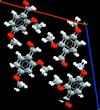issue contents
January 2019 issue

Cover illustration: The formation of a co-crystal involving 2,2'-dithiodibenzoic acid and benzoic acid is demonstrated through energy framework calculations, in which the interactions within the crystal packing are quantified in terms of energy. It is shown that the crystal is mainly directed by electrostatic forces owing to the presence of strong O-H O hydrogen bonds that lead to a directional packing topology. The study is of importance in understanding the fundamental underlying principals of crystal packing and formation for the better design of physicochemical properties such as the mechanical strength of a crystal. See: Tan & Tiekink [Acta Cryst. (2019). E75, 1-7].
O hydrogen bonds that lead to a directional packing topology. The study is of importance in understanding the fundamental underlying principals of crystal packing and formation for the better design of physicochemical properties such as the mechanical strength of a crystal. See: Tan & Tiekink [Acta Cryst. (2019). E75, 1-7].
research communications












































 journal menu
journal menu







































